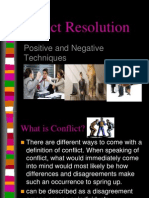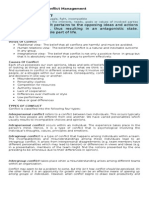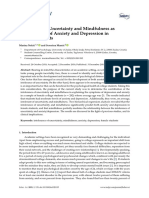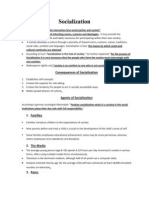0 ratings0% found this document useful (0 votes)
12 viewsESD
ESD
Uploaded by
amnaEducation for sustainable development
Copyright:
© All Rights Reserved
Available Formats
Download as DOCX, PDF, TXT or read online from Scribd
ESD
ESD
Uploaded by
amna0 ratings0% found this document useful (0 votes)
12 views3 pagesEducation for sustainable development
Copyright
© © All Rights Reserved
Available Formats
DOCX, PDF, TXT or read online from Scribd
Share this document
Did you find this document useful?
Is this content inappropriate?
Education for sustainable development
Copyright:
© All Rights Reserved
Available Formats
Download as DOCX, PDF, TXT or read online from Scribd
Download as docx, pdf, or txt
0 ratings0% found this document useful (0 votes)
12 views3 pagesESD
ESD
Uploaded by
amnaEducation for sustainable development
Copyright:
© All Rights Reserved
Available Formats
Download as DOCX, PDF, TXT or read online from Scribd
Download as docx, pdf, or txt
You are on page 1of 3
Conflict Resolution & Strategies to resolve conflicting resolution
Conflict: A conflict is a disagreement or problem between people. A conflict can
happen when people want, need or expect different things. All people experience
conflicts from time to time; conflicts are totally normal.
Conflict Resolution: Conflict resolution is the process of ending a dispute and
reaching an agreement that satisfies all parties involved. Since conflict is an essential
part of being human, effective conflict resolution is not designed to avoid
disagreements. Instead, conflict resolution skills are used to facilitate discussions,
increase understanding and control emotional responses.
Conflict Resolution Education: Conflict resolution education programs focus on
developing critical skills and abilities for a person to deal constructively with conflict.
In most cases these programs occur in schools, but they may also be used in after-
school programs, community centers, church groups, etc.
What do children learn in conflict resolution education?
These programs give children an understanding of the nature of conflict.
What is conflict?
How it develops?
What one can do to manage it?
Children learn that the existence of conflict is its natural, necessary, and important; its
just a disagreement about goals or methods to achieve those goals between two or
more than two people or group.
Its very important for Children to get aware with the variety of ways that they can use
to manage or respond to conflict; for that they learn and understand:
Dynamics of power and influence that operate in all conflict situations.
Role of culture
How we see and respond to conflict situations
To intellectually deal with the situation at hand; its very important to learn range of
conflict style such as “competing, collaborating, accommodating, avoiding, and
compromising”; and consider the advantages and disadvantages of each because no
one approach to manage conflict works all the time.
A violent response to any conflict is almost never an appropriate response. It’s a need
of time to provide social and emotional skills to every single child to prevent conflict
and reinforce their use of pro social strategies in conflict. Some of the skills that
conflict resolution education helps develop include:
Effective listening,
Perspective taking,
Emotional awareness, and
Emotional control
perspective taking
Conflict Resolution Strategies
Kenneth Thomas & Ralph Kilmann identified 5 conflict styles that vary in their
degrees of cooperativeness and assertiveness. Cooperativeness extent to which the
individual attempts to satisfy and consider the other individual's issues. Assertiveness
extent to which the individual attempts to satisfy own concerns.
Avoiding
Competing
Accommodating
Collaborating
Compromising
Five Methods for Managing Conflict Conflict has many sources in the workplace. It is
borne out of differences and will arise in any situation where people are required to
interact with one another.
Dealing with conflict effectively is a key management skill. This article outlines five
different approaches to conflict management and the situations they are most
appropriate for.
1.Accommodation 2. Compromise 3.Avoidance 4. Competition 5. Collaboration .
1: Competing
This is a win/lose situation. One party attempts to win the conflict through dominance
and power. This approach is best used: When all other methods have been tried (and
failed). In emergency situations when quick, immediate and decisive action is called
for. In situations where unpopular changes need to be applied and discussion is not
appropriate.
2: Collaborating
This is a win/win situation. It is the most effective but most difficult way of managing
differences. It requires trust and commitment on all sides to reach a resolution by
getting to the heart of the problem. All parties need to be willing to empathise and try
to understand each other’s situation
3: Compromising
This is a win/lose – win/lose situation, i.e. everyone involved gains and loses through
negotiation and flexibility. Each will win some of what they desire while at the same
time giving something up. The main goal of this approach is to find common ground
and maintain the relationship. Compromise is best used: To achieve an agreement
when all parties have equal power. To reach a temporary resolution in more
complicated matters. To achieve a settlement when time or other circumstances are
constrained.
4: Avoiding
This is a lose/lose situation. Neither party takes action to address the issues involved
in the conflict, meaning that it will remain unresolved. This approach is best used: If
all concerned feel that the issue is a minor one and will be resolved in time without
any fuss. When the parties need a chance to cool down and spend time apart. If other
people are able to resolve the conflict more effectively than the parties concerned.
When more time is needed before thinking about dealing with the issues. If the impact
of dealing with the situation may be damaging to all parties involved.
5: Accommodating
This is a lose/win situation. The accommodation approach is generally used when one
party is willing to forfeit their position. It is best used in situations where: One party
wishes to indicate a degree of fairness. People wish to encourage others to express
their own opinion. The issue or problem is more important to the other party
concerned. It is more important to safeguard the relationship rather than argue about
the issue.
Conclusion
Negotiating and keeping track of conflicts is hard but necessary work. It’s the key to
creating a culture of trust, and a workplace more employees look forward to being a
part of every day. And using the Thomas-Kilmann Conflict model is a great way to
start.
In my opinion collaboration is most appropriate; When all parties are willing to
investigate alternative solutions together that they may not necessarily have thought
of on their own. When trying to get to the source of problems that have continued for
a long time. When upholding objectives that cannot be compromised on any side
while still preserving the relationship. When parties from different backgrounds and
experiences are involved.
You might also like
- New Manager PlaybookDocument19 pagesNew Manager PlaybookKhairuddin Khairuddin100% (1)
- Five Methods For Managing ConflictDocument2 pagesFive Methods For Managing ConflictSharon AmondiNo ratings yet
- Family Conflict ResolutionDocument24 pagesFamily Conflict ResolutionDionyLisingGonzalesNo ratings yet
- A Case Study On Conflict ManagementDocument4 pagesA Case Study On Conflict ManagementMmeraKi0% (1)
- Management Conflict in Nursing WorkplacesDocument43 pagesManagement Conflict in Nursing WorkplacesElva Nattia Desti50% (8)
- Five Methods For Managing ConflictDocument2 pagesFive Methods For Managing ConflictachuNo ratings yet
- Oranisational Conflict ResolusionDocument4 pagesOranisational Conflict ResolusionLinto SophieNo ratings yet
- Conflict Manangement Term PPR RaniDocument5 pagesConflict Manangement Term PPR RaniRutujaNo ratings yet
- Workplace Conflict Resolution: People Management Tips by Susan M. Heathfield CDocument5 pagesWorkplace Conflict Resolution: People Management Tips by Susan M. Heathfield CNeha SahuNo ratings yet
- Module 3Document21 pagesModule 3Abhi GowdaNo ratings yet
- conflictresolution-130913120253-phpapp02Document20 pagesconflictresolution-130913120253-phpapp02mishaalahmad888No ratings yet
- ADR PresentationDocument79 pagesADR PresentationXandra Yzabelle T. EbdalinNo ratings yet
- Conflict and TransformationDocument122 pagesConflict and TransformationMacdonald MashawiNo ratings yet
- VER789Document10 pagesVER789Rida El MaakchaouiNo ratings yet
- Conflict ManagementDocument9 pagesConflict ManagementRonald KiptooNo ratings yet
- Exe DevelopmentDocument3 pagesExe Developmentbull jackNo ratings yet
- Conflict Management StylesDocument7 pagesConflict Management StylesEvgenia AmosovaNo ratings yet
- Non Agreessive Ways of Conflicy ResolutionDocument12 pagesNon Agreessive Ways of Conflicy ResolutionFarzana AfzalNo ratings yet
- Understanding Conflicting StylesDocument3 pagesUnderstanding Conflicting Stylesبريسكه طاهرNo ratings yet
- Emotional Intelligence Conflict ManagementDocument19 pagesEmotional Intelligence Conflict ManagementkhorshedNo ratings yet
- Conflict ManagementDocument5 pagesConflict ManagementBarbaraNo ratings yet
- Definition of Conflict ManagementDocument2 pagesDefinition of Conflict ManagementMaroden Sanchez GarciaNo ratings yet
- Conflict and Conflict ResolutionDocument17 pagesConflict and Conflict Resolutiontabithanjonjo98No ratings yet
- Conflict ResolutionDocument8 pagesConflict Resolutionbrsiwal1475100% (1)
- Conflict ResolutionDocument3 pagesConflict ResolutionSylvester KwakyeNo ratings yet
- Conflict Management and Resolution: AddressersDocument7 pagesConflict Management and Resolution: AddressersDennis ButtoNo ratings yet
- Updated Conflict Management and Resolution (Group5)Document14 pagesUpdated Conflict Management and Resolution (Group5)Andryas AbebeNo ratings yet
- Conflicts Management 1Document2 pagesConflicts Management 1rawalNo ratings yet
- Conflict ResolutionDocument13 pagesConflict ResolutionAnkit Bhattarai100% (1)
- Conflict Management StylesDocument2 pagesConflict Management StylesMelissa BlackNo ratings yet
- 5 Conflict Resolution Strategies We All UseDocument2 pages5 Conflict Resolution Strategies We All UseAgurang DatoyNo ratings yet
- Conflict ManagementDocument21 pagesConflict Managementfaizan khanNo ratings yet
- Conflict ResolutionDocument20 pagesConflict ResolutionAnonymous R0e5Nq100% (1)
- OB chapter 4Document7 pagesOB chapter 4betyhan24No ratings yet
- Conflict ResolutionDocument3 pagesConflict ResolutiontomoNo ratings yet
- Chapter-3 CM PCIUDocument27 pagesChapter-3 CM PCIUBhuiyan Mohammed Atik100% (1)
- Module 2 - CNMDocument20 pagesModule 2 - CNMaravinda.hgNo ratings yet
- Definition of Organizational CultureDocument5 pagesDefinition of Organizational CultureŠhő VØňNo ratings yet
- c4-74Document2 pagesc4-74Islam BasryNo ratings yet
- Conflict Management: What Are The Reasons or Sources For ConflictsDocument5 pagesConflict Management: What Are The Reasons or Sources For ConflictsPia YlananNo ratings yet
- Module 2 - CNMDocument22 pagesModule 2 - CNMaravinda.hgNo ratings yet
- Conflict Management StrategiesDocument7 pagesConflict Management Strategiessamaina.w2018No ratings yet
- Methods of Resolving Conflict - WPS OfficeDocument6 pagesMethods of Resolving Conflict - WPS OfficePsyNo ratings yet
- Conflict Res 4Document9 pagesConflict Res 4Sigmund WigginsNo ratings yet
- SOCIO-424-GROUP-3-CONFLICT-RESOLUTION-MODELDocument17 pagesSOCIO-424-GROUP-3-CONFLICT-RESOLUTION-MODELymatajulius457No ratings yet
- Conflict Resolution ManagementDocument6 pagesConflict Resolution ManagementCECILIA BRASUELANo ratings yet
- Conflict MGT Readings Assignment 01Document8 pagesConflict MGT Readings Assignment 01Shams Ul HayatNo ratings yet
- ExplanationDocument2 pagesExplanationMarie Faith MaramagNo ratings yet
- Assessment 2 Written AssessmentDocument4 pagesAssessment 2 Written Assessmenthoney arguellesNo ratings yet
- 5 Types of Conflict StylesDocument12 pages5 Types of Conflict StylesSaswata Msd ChakrabortyNo ratings yet
- Option 1 Conflict Resolution by Abdirasaq Islaan YaasiinDocument38 pagesOption 1 Conflict Resolution by Abdirasaq Islaan Yaasiinbarbaroonio5No ratings yet
- 1.2.08 - Managing Conflict EffectivelyDocument8 pages1.2.08 - Managing Conflict EffectivelyPrabath WithanageNo ratings yet
- Identifying Conflicts KNPCBTDocument13 pagesIdentifying Conflicts KNPCBTJohaifhaNo ratings yet
- Conflict NotesDocument6 pagesConflict Notessreelesh achari100% (1)
- Lecture 4 LeadershipDocument35 pagesLecture 4 Leadershipmohnsd1162002No ratings yet
- Conflict ManagementDocument8 pagesConflict Managementenelra08No ratings yet
- Resolving Conflict: Module 4 Lesson 1: Responses To Conflict Prepared By: Fatma Tahara M. Capal (Group 4)Document3 pagesResolving Conflict: Module 4 Lesson 1: Responses To Conflict Prepared By: Fatma Tahara M. Capal (Group 4)Hara Kye100% (1)
- Ao No 6 s14 Rules and Procedures For Cancellation of Emancipation Patents and Certificates of Landownership AwardDocument30 pagesAo No 6 s14 Rules and Procedures For Cancellation of Emancipation Patents and Certificates of Landownership AwardAxel Gotos dela VegaNo ratings yet
- 2 Slide What Is Conflict ?Document15 pages2 Slide What Is Conflict ?asd100% (1)
- Negotiating: Negotiation Mistakes and Mediation Skills for BeginnersFrom EverandNegotiating: Negotiation Mistakes and Mediation Skills for BeginnersNo ratings yet
- TDSB PPM 144Document4 pagesTDSB PPM 144api-286325388No ratings yet
- Blood Blood 2019 Bullying in Adolescents Who Stutter Communicative Competence and Self EsteemDocument11 pagesBlood Blood 2019 Bullying in Adolescents Who Stutter Communicative Competence and Self Esteemszabin.gereNo ratings yet
- Soc104 SyllabusDocument2 pagesSoc104 Syllabusapi-487336205No ratings yet
- Orems Self Care Deficit Nursing TheoryDocument30 pagesOrems Self Care Deficit Nursing TheoryAra Jean AgapitoNo ratings yet
- Risk and Criminogenic NeedsDocument2 pagesRisk and Criminogenic NeedsJoão FerreiraNo ratings yet
- Free Will Could All Be An Illusion, Scientists Suggest After Study Shows Choice May Just Be Brain Tricking Itself - Science - News - The IndependentDocument9 pagesFree Will Could All Be An Illusion, Scientists Suggest After Study Shows Choice May Just Be Brain Tricking Itself - Science - News - The IndependentLamaCNo ratings yet
- Positive Psychology and RelationshipsDocument7 pagesPositive Psychology and Relationships101wtfast101No ratings yet
- Peer PressureDocument1 pagePeer PressureVEDIKA TOMARNo ratings yet
- Stern1994 PDFDocument20 pagesStern1994 PDFazenaty alianNo ratings yet
- Writing ObjectivesDocument32 pagesWriting ObjectivesTita RakhmitaNo ratings yet
- Resistance To ChangeDocument7 pagesResistance To Changesuhanov21100% (1)
- 493 Lecture 6 EmotionDocument53 pages493 Lecture 6 EmotionMunhwa KangNo ratings yet
- Document PDFDocument277 pagesDocument PDFMadhu SudhanNo ratings yet
- Intolerance of Uncertainty andDocument10 pagesIntolerance of Uncertainty andZAINUL ANWARNo ratings yet
- Values Clarification ApproachDocument21 pagesValues Clarification ApproachLUIS, JOBERT V.100% (1)
- Case Study DraftDocument6 pagesCase Study DraftEntertainment Happenings PHNo ratings yet
- Life Review-Basic ConceptsDocument16 pagesLife Review-Basic ConceptsUdisha MerwalNo ratings yet
- SociologyDocument5 pagesSociologyM Ashraf BhattiNo ratings yet
- Office AdministrationDocument2 pagesOffice AdministrationSchool Account100% (2)
- Chapter 12Document2 pagesChapter 12freak13No ratings yet
- Job Design and Employee MotivationDocument19 pagesJob Design and Employee Motivationglamboyz100% (1)
- Pointer Performance EnvironementDocument3 pagesPointer Performance EnvironementAnton WiNo ratings yet
- Act and "Working With Parts": by DR Russ HarrisDocument15 pagesAct and "Working With Parts": by DR Russ HarrisRaphaele Colferai100% (1)
- ERQ EvolutionDocument6 pagesERQ EvolutionmayaNo ratings yet
- Organization Renewal: The Challenge of Change: An Experiential Approach To Organization Development 8 EditionDocument48 pagesOrganization Renewal: The Challenge of Change: An Experiential Approach To Organization Development 8 EditionduitNo ratings yet
- Social InteractionistDocument2 pagesSocial InteractionistjwayneathenNo ratings yet
- NRB Management MCQDocument32 pagesNRB Management MCQSajinaNo ratings yet
- Personal Development Quiz No. 1.1Document21 pagesPersonal Development Quiz No. 1.1Sir JohnNo ratings yet
- EXAMPLE OF Chapter 2 READING COMPREHENSIONDocument8 pagesEXAMPLE OF Chapter 2 READING COMPREHENSIONGian Andrei BenaguaNo ratings yet

























































































